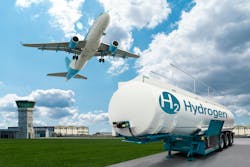The “AI” in Sustainable Initiatives: Profitable, Efficient, and Sustainable Aviation
Artificial Intelligence (AI) is being utilized for airlines, airports, and ground handlers to meet sustainability initiatives and more. With the United Nations 2030 Sustainable Development Goals, the aviation industry is looking to AI as a great tool to help them succeed in their journey to more sustainable air transport activities. This article will delve into the myriad of AI and sustainability aspects that encompass airport operations, from cargo and baggage loading to deicing and stand/gate management. AI is expected to play an exponentially increasing role in creating safe, reliable, and cost-effective ground handling activities.
Net-Zero Aim
Net-zero emissions by 2050 is the goal for the aviation industry and with that in mind, expect to see new fuel sources, optimal data-driven flight and ground operations, greener supply chains, and more sustainable air transport activities. Air traffic and transportation are vital components of global connectivity and economic growth. Given their significance, there is also a substantial opportunity to enhance sustainability within this sector. By implementing AI driven, eco-friendly practices and innovations, the environmental impact will be significantly reduced.
The Aviation Forecast is Bright
In the rapidly evolving aviation industry, aligning sustainability initiatives with economic objectives not only enhances operational efficiency but also drives substantial financial benefits. The integration of smart algorithms exemplifies how technological advancements can simultaneously reduce costs, elevate productivity, and enhance punctuality. AI is significantly revolutionizing ground operations by optimizing the utilization of ground support equipment (GSE), thereby minimizing emissions and fostering sustainability.
Moreover, AI's impact extends beyond just operational efficiency; it is instrumental in redefining critical ground activities, including maintenance, repair, and overhaul (MRO), as well as fleet optimization and flight planning. By leveraging AI, aviation professionals are not only improving the precision and efficiency of these processes but are also significantly cutting down on unnecessary fuel consumption, which is a major expense for airlines and ground handlers. For example, improving airport apron efficiency directly addresses the often overlooked but critical issue of excess engine or auxiliary power unit (APU) time usage. This not only reduces operational costs but also lessens environmental impact, making it a win-win scenario for the industry.
As the sector continues to prioritize efficiency, the dual benefits of economic gain and environmental responsibility are clear. AI’s capabilities to optimize operations while reducing fuel use and emissions highlight its role as a pivotal tool in achieving these twin goals. This strategic approach not only ensures compliance with evolving environmental regulations but also positions airlines for better financial performance amidst rising fuel costs. Therefore, it's imperative for aviation leaders to embrace these technological advancements, as they are essential for both sustainable growth and economic resilience in the face of global challenges.
AI and Sustainability in Pre-Flight Operations
Optimizing cargo and baggage loading processes can contribute to sustainability initiatives because algorithms can analyze factors like aircraft weight limits, cargo dimensions, and compartment capacities to generate optimized loading plans. By maximizing space utilization and minimizing wasted space, it potentially reduces the number of flights needed to transport the same amount of cargo. AI can also assist with weight and balance calculations, ensuring the aircraft is loaded within safe limits, preventing potential stability issues during flight. By evaluating the loading patterns and suggesting proper securing methods, AI can minimize the risk of cargo shifting or damage from happening during transport.
Uploading pre-prepared meals and refreshments for passengers and crew onto the aircraft can be tricky. Luckily, the use of AI in demand forecasting means historical data on passenger numbers, flight routes, and meal preferences can help predict demand for specific meals and drinks more accurately for future flights. Reducing food waste and ensuring airlines aren't loading unnecessary supplies helps with sustainability. AI could suggest the most efficient loading sequence based on weight distribution and temperature control needs among other factors.
Increased Flight Safety
AI can be used to analyze current situations in real-time while at the same time assessing historical weather data to predict icing conditions with greater accuracy. This data can then be leveraged to ensure crews are ready and available to perform de-icing/anti-icing. In addition, AI can help achieve better de-icing/anti-icing spraying equipment control to ensure a more precise application and minimize over spraying. This would help reduce fluid waste and lessen the environmental impact. Shortening the de-icing/anti-icing procedures minimizes the amount of time de-icing equipment operates, which helps reduce energy consumption.
Fuel and Energy Conservation
Connecting the aircraft to external power and air conditioning units while parked helps conserve fuel, as the aircraft's own engines are usually shut down for fuel conservation and noise reduction. AI algorithms can analyze historical data on flight schedules, turnaround times, and weather conditions to predict the demand for ground power units (GPU)/air units at different times of the day, which helps achieve a more efficient allocation of resources as well as avoids unnecessary idling.
By monitoring the real-time power needs of the aircraft and adjusting the output of the GPU accordingly, the over-supplying of power is reduced - another energy savings. Potentially using renewable energy sources can also lead to a significant reduction in overall fuel consumption and lower CO2 emissions for ground operations. AI can contribute to reduced air pollution around airports by simply minimizing diesel-powered generator usage, especially during peak demand periods, which helps to improve overall air quality.
Delivering a Better Customer Experience
With assisting passengers in safely exiting the aircraft -- whether using passenger stairs or an aerobridge for access to the terminal building -- algorithms can use historical patterns regarding passenger disembarkation and account for such factors as passenger numbers, cabin layout, and baggage distribution. This can help identify potential bottlenecks and optimize the disembarkation sequence for faster and smoother passenger flow. Additionally with dynamic signage and announcements, AI can analyze real-time data on passenger numbers and disembarkation progress to provide dynamic signage within the aircraft cabin or at the gate. This can guide passengers towards the most efficient exits and minimize congestion.
To determine the most efficient offloading sequence in unloading passenger luggage and cargo containers from the aircraft, AI algorithms can analyze factors like baggage compartment layout, passenger distribution, and baggage claim wait times. This is where AI can minimize wasted time and ensure faster unloading of baggage in addition to reducing the need for additional vehicles, which minimize fuel usage. Individual baggage items equipped with RFID tags allows for real-time monitoring of the offloading process and helps identify any potential delays or misplaced luggage. Reducing ground operation times, faster baggage offloading translates to shorter turnaround times for aircraft, minimizing the amount of time the engines are idling on the ground.
Lots of Small Improvements Add Up
For support in cleaning the aircraft cabin thoroughly, AI can analyze cleaning data to identify flights that typically require additional cleaning time or effort. AI can also help track cleaning supplies and restocking needs, improve cleaning routines, and allow for dynamic resource allocation. Crews are ensured the necessary resources are readily available without excess or wasted supplies. AI-optimized cleaning protocols means less water usage and chemical waste. Algorithms also can analyze waste data to dynamically allocate bin capacities based on typical waste volumes for specific aircraft types; thus, reducing overflowing bins and the need for extra waste collection trips.
AI is starting to transform aircraft pushback operations with increased efficiency, safety, and even sustainability. For instance, algorithms can factor in real-time data like weather conditions, ramp congestion, and aircraft type to calculate the optimal pushback path, ensuring smooth and efficient maneuvering. Ground crews benefit from a reduction in the potential for errors. AI-powered sensors that detect obstacles around the moving aircraft and the pushback tractor, can issue warnings or even take corrective actions to prevent collisions, which enhances safety on crowded airport aprons.
Since ground handling companies often offer basic aircraft and GSE maintenance services like topping up fluids or replacing worn-out parts, AI can provide early detection, ensuring a proactive maintenance schedule, which prevents unnecessary downtime and reduces the risk of larger, more time-intensive repairs. The algorithms analyze usage patterns and maintenance schedules so that spare parts can be delivered and available when needed, which has proven instrumental in further reducing inventory costs.
Optimization for Increasing Sustainability
Thanks to how AI is evolving and optimizing operations, smarter software support systems have become instrumental in ensuring airport aprons accommodate all arriving and departing aircrafts without delay; a great advantage in helping not only to increase customer satisfaction but also in saving on fuel costs and in reducing CO2 emissions. In fact, transformational AI software support systems have proven to be an indispensable component for sustainability initiatives deployed by airlines, airports, and ground handlers.
When an aircraft arrives at an airport, it must be able to park at an available gate or stand swiftly. A lot goes on behind the scenes to make this happen. Once parked, the aircraft must be unloaded and reloaded with passengers and baggage as quickly as possible. With AI-based software support systems, all of this happens like clockwork so that the aircraft can take off again without delaying other arriving or departing flights.
That being said, the responsible use of AI is crucial. That’s why INFORM put Responsible AI Guidelines into place for the purposes of ensuring trustworthy AI. For instance, AI-centric systems should enrich both users and society and avoid negative effects such as biases or misinformation. The role of AI should only ever be supportive. It is important that its results should be verifiable at any time and humans should always have ultimate responsibility and final say. In addition, AI should always be geared towards human and corporate goals and values.
Sustainability initiatives often go hand-in-hand with efficiency improvements. By working together, ground handlers, airlines and airports can achieve significant progress towards their sustainability goals by taking a more collaborative approach and utilizing AI-based software as a path to a greener aviation industry.



